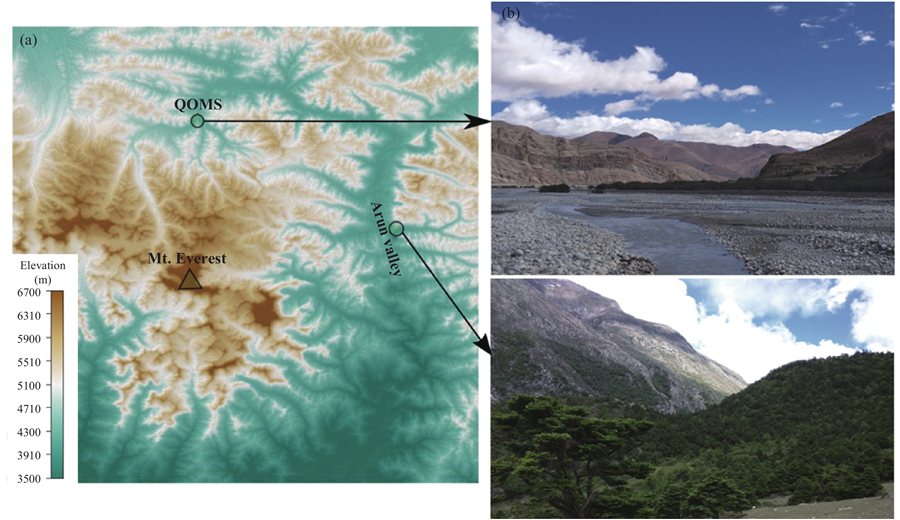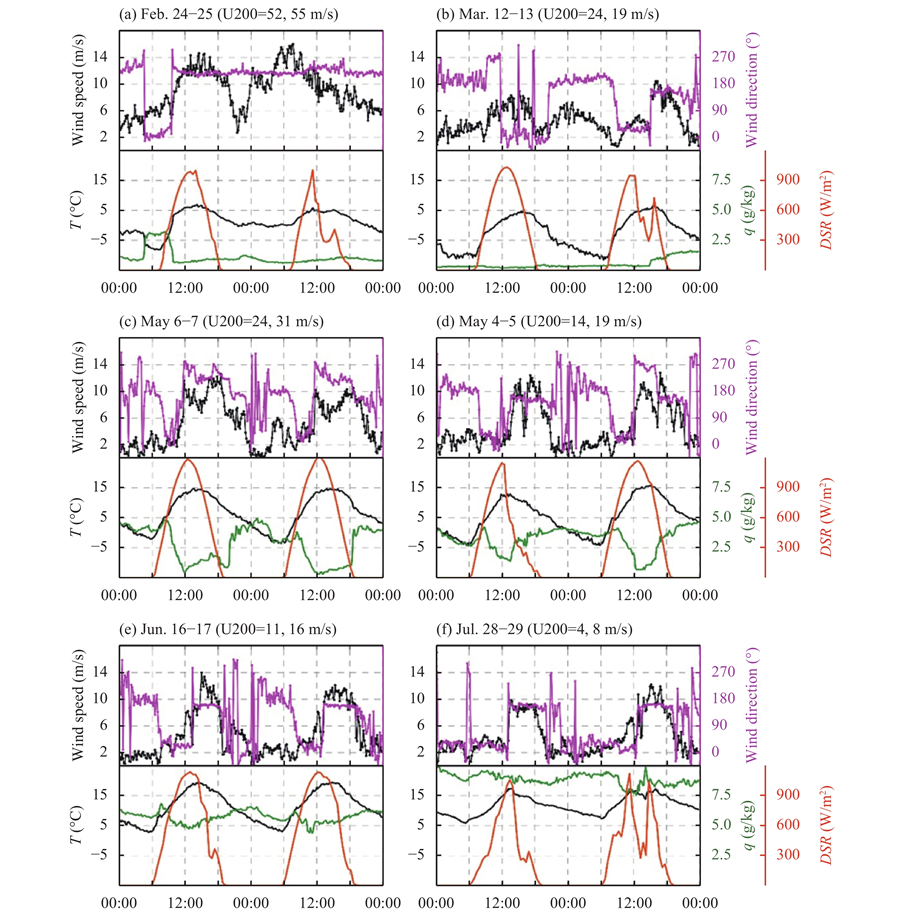Sciences in Cold and Arid Regions ›› 2018, Vol. 10 ›› Issue (6): 493–501.doi: 10.3724/SP.J.1226.2018.00493
Local meteorology in a northern Himalayan valley near Mount Everest and its response to seasonal transitions
FangLin Sun1,2,*( ),YaoMing Ma2,3,4,ZeYong Hu1,2
),YaoMing Ma2,3,4,ZeYong Hu1,2
- 1 Key Laboratory of Land Surface Process and Climate Change in Cold and Arid Regions, Northwest Institute of Eco-Environment and Resources, Chinese Academy of Sciences, Lanzhou, Gansu 730000, China
2 China University of Chinese Academy of Sciences, Beijing 100049, China
3 Key Laboratory of Tibetan Environment Changes and Land Surface Processes, Institute of Tibetan Plateau Research, Chinese Academy of Sciences, Beijing 100101, China
4 CAS Center for Excellence in Tibetan Plateau Earth Sciences, Beijing 100101, China
| 1 | Allaby M, 2010. Encyclopedia of Weather and Climate. Facts on File, Inc., New York. |
| 2 |
Bolch T, Kulkarni A, Kaab A, et al. The state and fate of Himalayan glaciers. Science 2012; 336: 6079 310- 314.
doi: 10.1126/science.1215828 |
| 3 |
Bonasoni P, Laj P, Marinoni A, et al. Atmospheric Brown Clouds in the Himalayas: first two years of continuous observations at the Nepal Climate Observatory-Pyramid (5079 m). Atmospheric Chemistry and Physics 2010; 10: 15 7515- 7531.
doi: 10.5194/acp-10-7515-2010 |
| 4 |
Cong ZY, Kang SC, Kawamura K, et al. Carbonaceous aerosols on the south edge of the Tibetan Plateau: concentrations, seasonality, and sources. Atmospheric Chemistry and Physics 2015; 15: 3 1573- 1584.
doi: 10.5194/acp-15-1573-2015 |
| 5 | Gautam MR, Timilsina GR, Acharya K, 2013. Climate Change in the Himalayas: Current State of Knowledge. Policy Research Working Papers, The World Bank. DOI: 10.1596/1813-9450-6516. |
| 6 |
Kennett EJ, Toumi R Himalayan rainfall and vorticity generation within the Indian summer monsoon. Geophysical Research Letters 2005; 32: 4 L04 802.
doi: 10.1029/2004GL021925 |
| 7 |
Ma SP, Zhou LB, Zou H, et al. The role of snow/ice cover in the formation of a local Himalayan circulation. Meteorology and Atmospheric Physics 2013; 120: 45- 51.
doi: 10.1007/s00703-013-0236-x |
| 8 |
Moore GWK, Semple JL High Himalayan meteorology: Weather at the South Col of Mount Everest. Geophysical Research Letters 2004; 31: 18 L18109.
doi: 10.1029/2004GL020621 |
| 9 |
Ohata T, Higuchi K, Ikegami K Mountain-Valley Wind System in the Khumbu Himal, East Nepal. Journal of the Meteorological Society of Japan. Ser. II 1981; 59: 5 753- 762.
doi: 10.2151/jmsj1965.59.5_753 |
| 10 |
Schiemann R, Luthi D, Schar C Seasonality and Interannual Variability of the Westerly Jet in the Tibetan Plateau Region. Journal of Climate 2009; 22: 11 2940- 2957.
doi: 10.1175/2008JCLI2625.1 |
| 11 |
Shah RDT, Sharma S, Haase P, et al. The climate sensitive zone along an altitudinal gradient in central Himalayan rivers: a useful concept to monitor climate change impacts in mountain regions. Climatic Change 2015; 132: 2 265- 278.
doi: 10.1007/s10584-015-1417-z |
| 12 |
Shea JM, Wagnon P, Immerzeel WW, et al. A comparative high-altitude meteorological analysis from three catchments in the Nepalese Himalaya. International Journal of Water Resources Development 2015; 31: 2 174- 200.
doi: 10.1080/07900627.2015.1020417 |
| 13 |
Sun FL, Ma YM, Hu ZY, et al. Mechanism of Daytime Strong Winds on the Northern Slopes of Himalayas, near Mount Everest: Observation and Simulation. Journal of Applied Meteorology and Climatology 2017; 57: 2 255- 272.
doi: 10.1175/JAMC-D-16-0409.1 |
| 14 |
Ueno K, Toyotsu K, Bertolani L, et al. Stepwise Onset of Monsoon Weather Observed in the Nepal Himalaya. Monthly Weather Review 2008; 136: 7 2507- 2522.
doi: 10.1175/2007MWR2298.1 |
| 15 |
Veettil B K, Bianchini N, Andrade AM, et al. Glacier changes and related glacial lake expansion in the Bhutan Himalaya, 1990-2010. Regional Environmental Change 2016; 16: 5 1267- 1278.
doi: 10.1007/s10113-015-0853-7 |
| 16 |
Wang B, Fan Z Choice of South Asian Summer Monsoon Indices. Bulletin of the American Meteorological Society 1999; 80: 4 629- 638.
doi: 10.1175/1520-0477(1999)080<0629:COSASM>2.0.CO;2 |
| 17 |
Webster PJ, Chou LC Seasonal Structure of a Simple Monsoon System. Journal of the Atmospheric Sciences 1980; 37: 2 354- 367.
doi: 10.1175/1520-0469(1980)037<0354:SSOASM>2.0.CO;2 |
| 18 |
Xu BQ, Wang M, Joswiak DR, et al. Deposition of anthropogenic aerosols in a southeastern Tibetan glacier. Journal of Geophysical Research: Atmospheres 2009; 114: D17
doi: 10.1029/2008JD011510 |
| 19 |
Yasunari TJ, Tan Q, Lau KM, et al. Estimated range of black carbon dry deposition and the related snow albedo reduction over Himalayan glaciers during dry pre-monsoon periods. Atmospheric Environment 2013; 78: 259- 267.
doi: 10.1016/j.atmosenv.2012.03.031 |
| 20 |
Zhou LB, Zou H, Ma SP, et al. Study on impact of the South Asian summer monsoon on the down-valley wind on the northern slope of Mt. Everest. Geophysical Research Letters 2008; 35: L14811.
doi: 10.1029/2008GL034151 |
| 21 |
Zou H, Zhou LB, Ma SP, et al. Local wind system in the Rongbuk Valley on the northern slope of Mt. Everest. Geophysical Research Letters 2008; 35: L13813.
doi: 10.1029/2008GL033466 |
| No related articles found! |








